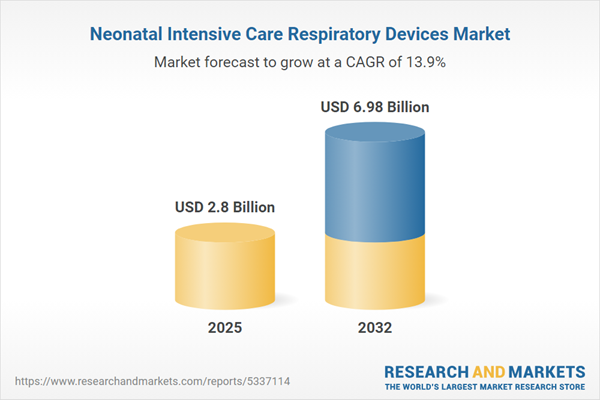Speak directly to the analyst to clarify any post sales queries you may have.
The neonatal intensive care respiratory devices market is undergoing significant transformation as digital integration, advanced care models, and infrastructure updates redefine neonatal respiratory support. Senior hospital leaders are actively seeking efficient, adaptive, and outcomes-focused solutions to meet increasing clinical complexity and operational demands.
Market Snapshot: Neonatal Intensive Care Respiratory Devices Market
The global neonatal intensive care respiratory devices market is experiencing steady and robust growth, highlighted by a compound annual growth rate (CAGR) of 13.94%. This expansion is propelled by the accelerated pace of workflow digitalization within neonatal intensive care units (NICUs) and ongoing advancements in clinical innovation. Healthcare providers in North America, Europe, Asia-Pacific, and the Middle East & Africa are prioritizing upgrades to infrastructure and unified protocols, which collectively shift neonatal respiratory care toward a data-centric and interoperable model. The growing adoption of digital solutions and changing regulatory frameworks require both incumbents and new market entrants to revise solution portfolios. These shifts ensure operational alignment with evolving standards and the increasing demands of neonatal patient care, ultimately supporting the objectives of clinical quality and organizational efficiency.
Scope & Segmentation
- Product Types: Solutions include continuous positive airway pressure systems, conventional ventilators, high-frequency ventilators, and oxygen hoods. These address a wide spectrum of neonatal respiratory needs, supporting tailored clinical responses across various patient profiles.
- Technology: Devices span invasive and non-invasive modalities, integrating dual-controlled ventilation, advanced pressure-volume controls, high-frequency oscillation, and user-focused digital interfaces. This combination enhances individual patient support while streamlining staff workflows.
- Modes: Dual-controlled, pressure-controlled, and volume-controlled configurations enable clinicians to personalize or standardize ventilation strategies in line with specific case requirements, promoting consistent care delivery.
- End Users: Hospitals, neonatal centers, and clinics rely on these systems to improve patient throughput, elevate staff competency, and maintain alignment with best practices in neonatal respiratory therapy.
- Applications: Core clinical applications encompass apnea monitoring, oxygen therapy, and respiratory weaning. These procedures play a critical role in reducing complications and ensuring smooth transitions across neonatal care pathways.
- Regions: Mature healthcare markets place significant emphasis on comprehensive digital solutions and large-scale modernization of clinical workflows. In contrast, emerging markets focus on incremental upgrades attuned to infrastructure and policy realities.
- Key Companies: Major providers such as Koninklijke Philips N.V., General Electric Company, Drägerwerk AG & Co. KGaA, Medtronic plc, Fisher & Paykel Healthcare Corporation Limited, Hamilton Medical AG, Smiths Group plc, Becton, Dickinson and Company, ResMed Inc., and Natus Medical Incorporated deliver devices engineered to support evolving clinical practices and regulatory requirements.
Key Takeaways for Senior Leaders
- Automated neonatal respiratory devices improve clinical workflow efficiencies by minimizing manual intervention and facilitating standardized protocols throughout a range of care environments.
- User-oriented device interfaces and ventilators powered by algorithms reduce onboarding complexity, enabling staff to swiftly adopt protocols and deliver enhanced neonatal respiratory care.
- Rising rates of preterm births are fueling demand for mobile and point-of-care respiratory solutions, broadening access to specialized care and enabling continuity outside centralized NICU facilities.
- Implementing modular, software-enabled platforms ensures smooth device interoperability, allowing facilities to adapt quickly to new clinical guidelines and market shifts while optimizing operational response.
- Collaboration with manufacturers, technology integrators, and health organizations strengthens device durability and supports faster adaptation to changing regulations and models of care delivery.
Tariff Impact on Market and Supply Chain
- Tariffs on key components from the United States are prompting medical device manufacturers to diversify their supplier bases and reassess sourcing strategies, which enhances resilience across international supply chains.
- Healthcare organizations are expanding partnerships and refining assembly processes to preserve operational continuity and protect against volatility in the market or regulatory landscape.
- Procurement is trending toward consolidated purchasing and integrated service agreements, fostering more transparency and reliability in the provision of respiratory devices for healthcare networks.
Methodology & Data Sources
This analysis synthesizes input from clinical practitioners, biomedical engineers, procurement experts, and regulatory advisors. The findings are based on peer-reviewed studies, industry literature, and established regulatory resources, with the goal of delivering actionable insights for senior decision-makers in the neonatal intensive care respiratory devices market.
Why This Report Matters
- Enables leadership teams to guide digital transformation initiatives in NICU respiratory care by aligning device adoption with evolving strategic and operational objectives.
- Clarifies changing patterns in supply chain and regulatory environments, supporting continuous neonatal respiratory services and helping institutions maintain compliance through unpredictable market changes.
- Offers clear guidance for procurement and planning teams, ensuring technology integration and device adoption are in harmony with broader organizational priorities.
Conclusion
This report equips senior leaders with a clear view of the opportunities and challenges in neonatal respiratory care. By leveraging current trends and actionable insights, decision-makers can strengthen organizational adaptability and maintain quality in evolving healthcare contexts.
Additional Product Information:
- Purchase of this report includes 1 year online access with quarterly updates.
- This report can be updated on request. Please contact our Customer Experience team using the Ask a Question widget on our website.
Table of Contents
3. Executive Summary
4. Market Overview
7. Cumulative Impact of Artificial Intelligence 2025
Companies Mentioned
The companies profiled in this Neonatal Intensive Care Respiratory Devices market report include:- Koninklijke Philips N.V.
- General Electric Company
- Drägerwerk AG & Co. KGaA
- Medtronic plc
- Fisher & Paykel Healthcare Corporation Limited
- Hamilton Medical AG
- Smiths Group plc
- Becton, Dickinson and Company
- ResMed Inc.
- Natus Medical Incorporated
Table Information
| Report Attribute | Details |
|---|---|
| No. of Pages | 183 |
| Published | October 2025 |
| Forecast Period | 2025 - 2032 |
| Estimated Market Value ( USD | $ 2.8 Billion |
| Forecasted Market Value ( USD | $ 6.98 Billion |
| Compound Annual Growth Rate | 13.9% |
| Regions Covered | Global |
| No. of Companies Mentioned | 11 |









